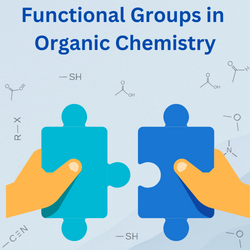Carbon's nondiscriminatory nature to form bonds with itself and other elements has led to a wide variety of small and large organic compounds. Carbon-hydrogen compounds called hydrocarbons are mostly inert; however, carbon with other elements (N, O, S, halogen) form functional groups, the reactive part of the molecule. The functional group part of the molecule is where chemical transformations occur. Some organic compounds can have more than one functional group.
While representing the molecular structure, chemists used to letter R to represent the 'Rest of the Molecule' to keep the inert hydrocarbon part of the molecule out of focus and only keep the functional groups in focus. The functional groups can now be easily identified, classified, and studied for their unique reactivity.
In the examples below, the R is the rest of the chemically non-interfering hydrocarbon part of the molecule (in red). The chemically active functional groups are alcohol (-OH), acid (-COOH), and cyanide (-CN).

Consider a molecule with an alcohol functional group (-OH) and its reaction with another molecule having a carboxylic acid functional group (-COOH). On reaction, an addition compound of functional group ester is obtained.

The hydrocarbon part of the two molecules didn't undergo any changes and can safely be abbreviated as R.

R1 or R' (R2 or R", R3 or R'") is sometimes used to differentiate the alkyl side chains on the same or other molecules.
Significance of R-abbreviation
R groups are particularly important in representing bulky, complex biomolecules- for example, the penicillin class of compounds are essential drugs for treating infections.
A different generation of superior acting drugs (benzyl penicillin, ampicillin, amoxicillin) are created over the original framework.

A glycoside is a molecule in which a sugar is bound to another functional group via a glycosidic bond. Many plant glycosides are an important precursor to making medicines so studying their chemistry is of utmost importance. While highlighting the reactive part of the molecule, the rest is hidden as the R group.
An example of methyl glycoside formation is shown as-

Different lengths of the carbon chain in dicarboxylic acids can be abbreviated using an R. For example, dicarboxylic Acids of the type- HOOC-R-COOH, where R represents the Alkyl groups.

